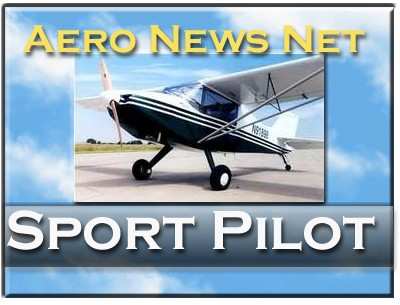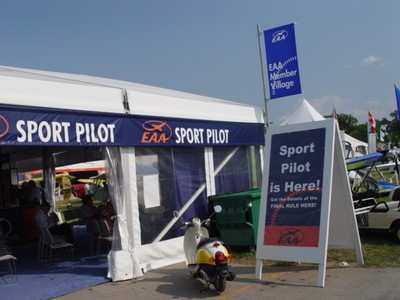A Month-By-Month Chronicle
By ANN Correspondent John Ballantyne
January
As we entered 2004, the focus was on the Office of Management
and Budget (OMB). At OMB sport pilot/light sport aircraft began a
second review period (actually start counting as of December 23,
2003). If the proposal got blessed by OMB, the FAA could issue
sport pilot as a final rule.

February - March
The FAA again assured everyone that sport pilot was a top
priority within the administration and reiterated the goal of
release of a final rule by late summer.
Public and aviation industry confidence in the FAA was further
weakened because of so many broken time deadlines and seemingly
endless bureaucratic processes. Concern began to surface many
places about the damaging effects of waiting so long for an
"imminent" rule change. There was noticeable damage to the
recreational aviation community who had stopped buying and building
aircraft to "see what would happen." Already starving instructors
(who do you know that got rich by instructing flight?) and
struggling manufactures were really feeling the strain of
wait-for-the-rule paralysis.

By mid-spring the Office of Management and Budget stamped "OK"
on the Sport Pilot proposal. This opened the way for FAA to
actually release the rule. the FAA promised to release the rule
soon (again).
July 20
The FAA actually releases sport pilot! Administrator Marion
Blakey officially unveiled the long-awaited Sport Pilot and Light
Sport Aircraft rule. The aviation media touted it as
the way for existing (older?) pilots to fly using only a valid
driver's license in lieu of an FAA medical certificate. Sport Pilot
was also seen as a less-expensive way to become a pilot. Presumably
this meant that there would be a significant influx of new pilots.
The rule became effective on September 1 FAA began to implement it
in stages.
September 1
 This was the effective date of the
Sport Pilot Rule. On this day, any FAA certificated private pilot
or better could operate under Sport Pilot privileges (with no tests
or endorsements) so long as they had a flight review within the
prescribed time (Per FAR 61.23), have not had an FAA medical
certificate refused or revoked, possess a current driver's license
and "not know or have reason to know of any medical condition that
would make that person unable to operate a light-sport aircraft in
a safe manner." FAA certificate holders could fly any category and
class already on their FAA certificate. This meant that if you had
Airplane Single Engine Land (SEL) ticket, then you could operate
any ASEL that met the definition of Light Sport Aircraft.
This was the effective date of the
Sport Pilot Rule. On this day, any FAA certificated private pilot
or better could operate under Sport Pilot privileges (with no tests
or endorsements) so long as they had a flight review within the
prescribed time (Per FAR 61.23), have not had an FAA medical
certificate refused or revoked, possess a current driver's license
and "not know or have reason to know of any medical condition that
would make that person unable to operate a light-sport aircraft in
a safe manner." FAA certificate holders could fly any category and
class already on their FAA certificate. This meant that if you had
Airplane Single Engine Land (SEL) ticket, then you could operate
any ASEL that met the definition of Light Sport Aircraft.
There was much celebration by individuals, companies and member
associations -- particularly the EAA -- who had been dominant in
the development of sport pilot. EAA had established a Sport Pilot
magazine months earlier and hosted a Sport Pilot Member Center at
the AirVenture EAA Convention in Oshkosh, Wisconsin, which began
shortly after FAA officially released sport pilot.
Release of the regulation began a series of FAA actions to
implement Sport Pilot including specific guidance, policy, and
infrastructure necessary for the public to conduct operations and
seek certification under the new regulations.

October 15
FAA began accepting requests for aircraft registration
(N-numbers) from ultralight owners who want to transition their
planes to experimental light-sport aircraft. (FAA form 8050-2,
Aircraft Registration Form and form 8050-88A-Affidavit of
ownership.) Aircraft airworthiness inspections are not yet
available, however.
October 19
FAA publishes form 8710-12, Light-Sport Standardization
Board-Designated Pilot Examiner Candidate Application. This form
allows individuals to apply to FAA for consideration as sport pilot
examiners.
October 28-31
The first US Sport Aviation Expo is held October 28-31, in
Sebring, Florida, the home of Lockwood Aviation. This event was
created for Light Sport Aircraft and Sport Pilots.
November 5
FAA published Airman Knowledge Test questions. These questions
are some of those used on the written tests for sport pilot and
sport pilot instructor/examiner. The question bank includes
questions related to weight-shift trikes and powered
parachutes.
November 15
FAA published the Sport Pilot Examiner Handbook (FAA Order
8710.7). This document established guidance and procedures for
pilot examiners. Included are privileges, responsibilities and
limitations of pilot examiners.
November 15
FAA began accepting sport pilot student pilot application form
(8710-1). The form must be completed and taken to a Flight
Standards District Office (FSDO) or designated pilot examiner (DPE)
before beginning to log instruction toward a sport pilot
certificate.
November 29
FAA convened the first Light-Sport Standardization Selection
Board (LSSB). This board determined which applicants for Sport
Pilot Examiner (DPE) will be invited to the first training seminar.
Pilot Examiners are those individuals who are authorized to conduct
FAA practical tests (oral and flight) for new sport pilots and
sport pilot instructors. FAA will conduct the first DPE training
seminar in Sebring, Florida, on January 17-22, 2005.
December 2
FAA released technical guidance (8700.34) to Flight Standards
District Offices (FSDO) related to the procedures for issuing sport
pilot student certificates.
December 13
FAA published Order 8130.33 which established procedures for
selection and appointment of Light-sport Aircraft Designated
Airworthiness Representatives (LSA-DAR) and the FAA Airworthiness
Office (MIDO) Light Sport Aircraft-DAR selection processes.
 ANN's Daily Aero-Linx (04.15.24)
ANN's Daily Aero-Linx (04.15.24) Classic Aero-TV: 'No Other Options' -- The Israeli Air Force's Danny Shapira
Classic Aero-TV: 'No Other Options' -- The Israeli Air Force's Danny Shapira Aero-News: Quote of the Day (04.15.24)
Aero-News: Quote of the Day (04.15.24) Airborne 04.16.24: RV Update, Affordable Flying Expo, Diamond Lil
Airborne 04.16.24: RV Update, Affordable Flying Expo, Diamond Lil ANN's Daily Aero-Term (04.16.24): Chart Supplement US
ANN's Daily Aero-Term (04.16.24): Chart Supplement US






